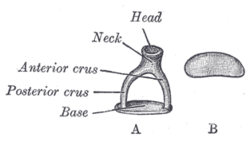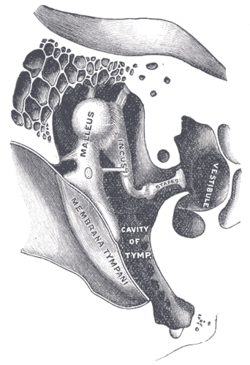സ്റ്റേപിസ്
ഒരു ചെറിയ ഓസിക്കിൾ അസ്ഥിയാണ് സ്റ്റേപിസ്. ഇൻകസിനോടും ഓവൽ ജാലകത്തോടുമാണ് ഇത് യോജിച്ചിരിക്കുന്നത്. ശരീരത്തിലെ ഏറ്റവും ചെറുതും ഭാരം കുറഞ്ഞതുമായ അസ്ഥിയാണ് സ്റ്റേപിസ്. പ്രഫസർ ജിയോവാനി ഫിലിപ്പോ ഇൻഗ്രാസ്സിയയാണ് 1546-ൽ നേപ്പിൾസ് സർവകലാശാലയിൽ ഇതിനെ ശാസ്ത്രത്തിന് മുന്നിൽ എത്തിച്ചത്.
| Bone: സ്റ്റേപിസ് | |
|---|---|
 | |
| A. ഇടത്തേ സ്റ്റേപിസ്. B. ഇടത്തേ സ്റ്റേപിസ്, മീഡിയൽ പ്രതലം. | |
 | |
| ഓസിക്കിളുകളും ലിഗമെന്റുകളും, മുന്നിൽ നിന്നുള്ള കാഴ്ച്ച. | |
| മദ്ധ്യകർണ്ണത്തിലെ അസ്ഥികളും പേശികളും | |
| Gray's | subject #231 1045 |
| Precursor | 2nd branchial arch[1] |
| MeSH | Stapes |
കർമം
തിരുത്തുകഇൻകസ് അസ്ഥിയിൽ നിന്നും ശബ്ദവീചികൾ ഓവൽ ജാലകത്തിൽ എത്തിക്കുകയാണ് സ്റ്റേപിസ് ചെയ്യുന്നത്. ഫേഷ്യൽ നാഡി നിയന്ത്രിക്കുന്ന സ്റ്റപീഡിയസ് പേശിയാണ് സ്റ്റേപിസിനെ ഉറപ്പിച്ച് നിർത്തുന്നത്..[2]
ഭ്രൂണത്തിലെ രൂപപ്പെടൽ
തിരുത്തുക6 മുതൽ 8 ആഴ്ച്ചവരെയുള്ള ഗർഭകാലത്താണ് സ്റ്റേപിസ് രൂപപ്പെടുന്നത്. ആ സമയത്ത് ഭ്രൂണത്തിന്റെ തലയുടെ ഭൂരിഭാഗത്തും രക്തമെത്തിക്കുന്ന സ്റ്റപീഡിയൽ ധമനിക്ക് ചുറ്റുമാണ് സ്റ്റേപിസ് നിലകൊള്ളുന്നത്. പിന്നീട് എക്സ്റ്റേണൽ കരോട്ടിഡ് ധമനി രൂപപ്പെട്ട് തലയിലേക്ക് രക്തമെത്തിക്കുന്ന ജോലി ഏറ്റെടുക്കുമ്പോൾ സ്റ്റേപിസിൽ ജനാല പോലെ ഒരു ദ്വാരം ബാക്കിയാവും.
നോട്ടുകൾ
തിരുത്തുക- ↑ hednk-023 — Embryo Images at University of North Carolina
- ↑ "Dissector Answers - Ear & Nasal Cavity". University of Michigan. Archived from the original on 2006-08-24. Retrieved January 2010.
{{cite web}}: Check date values in:|accessdate=(help)
ലേഖന സൂചിക
തിരുത്തുകപുറത്തേയ്ക്കുള്ള കണ്ണികൾ
തിരുത്തുക- "Development of mammal skull from primitive reptile skull". archive.org. Archived from the original on 2006-11-11. Retrieved January 2010.
{{cite web}}: Check date values in:|accessdate=(help) - "Reptilia Lab". Juniata Collage. Archived from the original on 2010-06-14. Retrieved January 2010.
{{cite web}}: Check date values in:|accessdate=(help) - "3-D Virtual Models of the Human Temporal Bone and Related Structures". Eaton Peabody Laboratory of Auditory Physiology. Archived from the original on 2018-10-24. Retrieved January 2010.
{{cite web}}: Check date values in:|accessdate=(help)
